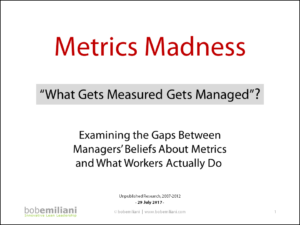 Unfortunately, most people mindlessly believe the statement: “What gets gets measured gets managed.” Click here to learn how this statement is easily proven to be untrue. The commonly believed statement “If the worker hasn’t learned, then the instructor hasn’t taught” is also easily proven to be untrue. Statements such as these must be verified before they are put into use because they will lead to poor decisions and unintended consequences.
Unfortunately, most people mindlessly believe the statement: “What gets gets measured gets managed.” Click here to learn how this statement is easily proven to be untrue. The commonly believed statement “If the worker hasn’t learned, then the instructor hasn’t taught” is also easily proven to be untrue. Statements such as these must be verified before they are put into use because they will lead to poor decisions and unintended consequences.
To further prove how absurd it is to think “what gets gets measured gets managed,” I gave the following homework assignment for many years to graduate students in my Lean Leadership course:
“List 3 to 5 metrics used in your department to track performance. Identify the favorable beliefs that must exist in the mind of senior management in order to support the use of these metrics. What are the resulting unfavorable behaviors and unfavorable competencies among the workers who are held accountable to the metrics?”
Where “belief” means something accepted as true; “behavior” is the conduct that results from the metric, and “competency” is a skill or capability that workers get good at doing (Please note that my students are full-time working professionals with an average of 10+ years of work experience. Therefore, their answers reflect real-world conditions).
Click on the image to view the results, which are quite remarkable. I always wanted to write an academic journal paper on these findings but never got around to it. I hope the results are useful to you and that you make changes to your metrics to eliminate the gaps, respect workers, and simplify workers’ accountability to metrics so they can focus on doing the right things.
ANALYSIS AND IMPROVEMENT OPPORTUNITY
The gap between what managers believe about the metric (“plan”) and the resulting worker behaviors and competencies (“actual”) is source of variation that results in unintended consequences – confusion, compliance, obfuscation, etc. The results show that leaders must be attentive to cause-and-effect relationships for metrics. Frequently, neither the metric nor workers’ competencies result in the elimination of waste, unevenness, and unreasonableness, and it does not improve the workplace or customer satisfaction.
Senior managers must therefore be very discriminating in the use of performance metrics and understand the effect that performance metrics have on employees (and others such as suppliers). Too often they assume metrics that have been in use for a long time, or metrics calculated by software systems, have been vetted long ago and are good and appropriate to use. That is a bad assumption, which illustrates an unwillingness to question things and ask “Why?” Leaders must not blindly accept metrics that have a big impact on the people who do the work every day
The gaps demonstrate management’s lack of awareness of what is actually going on and disinterest in both continuous improvement and respect for people. This is management’s problem to correct. Managers must never blame the workers.
